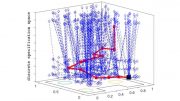
Charles Chalfant, Ph.D. Credit: VCU Massey Cancer Center
An international team of researchers has discovered a new protein called ceramide-1 phosphate transport protein (CPTP) that has the potential to aid in the treatment of cancer and other diseases.
In cancer research, discovering a new protein that plays a role in cancer is like finding a key and a treasure map: follow the clues and eventually, there could be a big reward. At least that’s the hope from a new study published in the journal Nature that discovered a novel protein called ceramide-1 phosphate transport protein (CPTP) – a finding that could eventually lead to the development of new drugs to treat a variety of cancers and other conditions involving inflammation and thrombosis, or blood clotting.
The identification of CPTP was the result of an international collaboration that built on prior research by co-lead author Charles Chalfant, Ph.D., Endowed Chair of Cancer Cell Signaling and member of the Cancer Cell Signaling program at Virginia Commonwealth University Massey Cancer Center as well as professor in the Department of Biochemistry and Molecular Biology at VCU School of Medicine. The team discovered that CPTP regulates levels of biologically active lipids, which are molecules such as fatty acids that often play a role in cell signaling. As its name implies, this study determined that CPTP’s main function is to transport ceramide-1-phosphate (C1P), a lipid that helps regulate cell growth, survival, migration, and inflammation. Specifically, C1P increases the production of pro-inflammatory eicosanoids – powerful signaling molecules that contribute to chronic inflammation in diseases such as cancer, asthma, atherosclerosis, and thrombosis – and the discovery of CPTP shines a light on the cellular mechanisms that contribute to these diseases.
“We may have identified the newest target for treating cancer,” says Chalfant. “Because of the important role this protein plays in a number of cellular functions, it could also have large implications for a variety of diseases like cancer that are caused by inflammation.”
With assistance from Massey’s Lipidomics Developing Shared Resource core, the researchers were able to determine the composition of the bioactive lipids regulated by CPTP. Residing in the cytosol, or the liquid within cells, the team found that CPTP regulates catabolism of C1P, a process that breaks down the molecule in order to release its energy. They also demonstrated that CPTP transports C1P to the cellular membrane where it helps synthesize eicosanoids from fatty acids in the membrane.
Confirming a decade of research from Chalfant’s laboratory, the scientists provided further proof that C1P regulates group IVA phospholipase A2, an enzyme that promotes inflammation through the production of a fatty acid known as arachidonic acid. The release of arachidonic acid via C1P activation of this enzyme was shown to trigger the production of eicosanoids. These findings help to explain the reported link between ceramide kinase, the enzyme responsible for C1P production, and poor prognosis in breast cancer patients, which further suggests that alleviation of systemic inflammation may lead to better prognosis and better treatment responses.
“Moving forward, we hope to use our knowledge of the structure of CPTP in order to find small molecules and other means that can block it,” says Chalfant. “The immediate uses of such therapeutics might be to restore clotting in trauma patients by maintaining the levels of specific eicosanoids that mediate blood clotting. However, with further research, we hope to define exactly how CPTP is produced so that we can regulate its production and potentially develop new treatments for a variety of diseases.”
Chalfant collaborated on this study with co-lead author Rhoderick Brown, Ph.D., from the University of Minnesota; Dayanjan S. Wijesinghe, postdoctoral fellow in the Department of Biochemistry and Molecular Biology at VCU School of Medicine; Dhirendra Simanshu, Ph.D., from Memorial Sloan-Kettering Cancer Center; Dinshaw Patel, Ph.D., a member of the National Academy of Sciences from Memorial Sloan-Kettering Cancer Center; Xianqiong Zou, Ravi Kanth Kamlekar, Xiuhong Zhai, Shrawan Mishra and Edward Hinchcliffe, Ph.D., all from the University of Minnesota; Julian Molotkovsky from the Russian Academy of Sciences in Moscow, Russia; and Lucy Malinina from CIC bioGUNE in Derio-Bilbao, Spain.
This study was supported by National Institutes of Health grants R01 CA154314, R01 HL72925-S1, R01 HL72925; Veterans Administration Merit Review I, BX001792; Virginia Commonwealth University Higher Education Equipment Transfer Fund; and, in part, by VCU Massey Cancer Center’s NIH-NCI Cancer Center Support Grant P30 CA016059.
Reference: “Non-vesicular trafficking by a ceramide-1-phosphate transfer protein regulates eicosanoids” by Dhirendra K. Simanshu, Ravi Kanth Kamlekar, Dayanjan S. Wijesinghe, Xianqiong Zou, Xiuhong Zhai, Shrawan K. Mishra, Julian G. Molotkovsky, Lucy Malinina, Edward H. Hinchcliffe, Charles E. Chalfant, Rhoderick E. Brown and Dinshaw J. Patel, 17 July 2013, Nature.
DOI: 10.1038/nature12332









Be the first to comment on "Newly Discovered Protein Offers Vast Potential for Cancer Treatment"